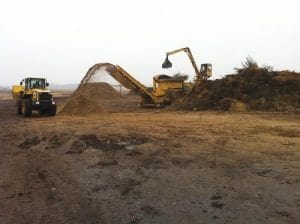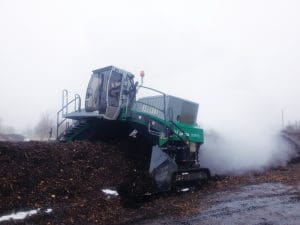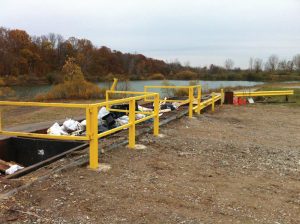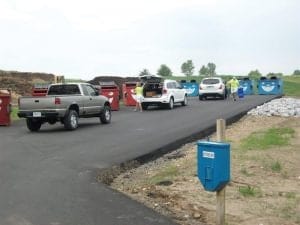With unique challenges across a rural setting, Northeast Indiana Solid Waste District develops innovative solutions to recycling, hazardous waste, composting, public education and more as they put together programs that are outside of the box.
The Northeast Indiana Solid Waste District (NISWMD) (Ashley, IN) was created by the general assembly in May 1991 to assist in the reduction of solid waste through reducing, reusing, recycling and composting programs. This regional District consists of four counties—DeKalb, LaGrange, Noble and Steuben—spreading over 1,400 square miles and serving a population of about 56,000 people. With a population density of 106 people per square mile, the District is in a very rural setting (60 percent rural and 40 percent urban), however, it does generate about 200,000 tons of municipal solid waste per year. The District is governed by elected officials from the four representative counties (see NISWMD Board of Directors sidebar, page xx) and employs a staff of employs a full-time staff of six and a dozen part-time staff.
Flagship Programs
While many of the solid waste districts in the state remain single county, which is very difficult from a material handling standpoint because of economies of scale, budgeting/funding across a larger footprint, etc., the NISWMD is not only one of the few regional districts, but also one of the few that is successful. The largest city in the District is Auburn, which has a population of 12,000 and is a bedroom community north to the city of Fort Wayne, the second largest city in the state. Across the district to the LaGrange area, it is heavily Mennonite and Amish communities. Straight up to Angola in Steuben County, there are a lot of lakes (101) and major resort areas. Says Steven Christman, NISWMD’s Executive Director, “Part of our challenge is the great changes in areas as you move across the district. That is why we are so unique and why we have to come up with ways to think outside of the box and manage our recycling and hazardous waste material in a rural setting. It is very different from the major cities. When you go regional, you can find funding, which allows you to hire qualified people that understand the issues as well, so you can get those experts out there that can craft and put together programs that are solutions to those challenges.”
NISWMD’s budget is primarily funded from the property tax base, which is approximately one penny per $100 of net assess evaluation. Says Christman, “The tax rate is quite small, which is one of the many benefits of being a regional district. It generates about $1.5 million per year and that allows us to provide a number of programs, especially our four flagship ones: recycling drop-off, composting, household hazardous waste and public education.”
Recycling Drop-Off Program
The rural recycling drop-off program has been in existence since the beginning of the district (25 years ago) and consists of 17 rural unmanned drop-off points across the four counties; the items dropped off by residents are picked up by a contracted private sector service provider. The cost of the program is $115 to $120 per ton, which includes administrative and cleanup costs.
Yard Waste Composting

Images courtesy of the Northeast Indiana Solid Waste District.
As another one of the NISWMD’s flagship programs, yard waste composting is operated as a state registered (by the Indiana Department of Environmental Management) compost lot in each of the four counties that make up the district. With their own equipment, including tub grinders, windrow turners, trucks, trailers and support equipment, they are able to custom grind at 12 locations across the district for some of the cities and towns. The finished compost product has a mixture of leaves and grass and they make a couple of different grades of wood mulch as well. A crew of three men have traveled the district and set up the program since 1992, allowing it to be extremely mobile. From there, the program has continued to grow over the years, handling and processing anywhere from 10,000 tons to 21,000 per year of yard waste.
Household Hazardous Waste
The NISWMD’s household hazardous waste program operates primarily from April through November, although, due to demand, Christman sees it becoming a year-long program at the Ashley complex within three to four years. The Ashley site is 31-acres with a district office, aggregation building and maintenance shop. The public visits this location every Friday morning and can drop off electronics, fluorescent bulbs, TVs, used oil, paint, etc. when a chemist is onsite through the contractor that they partner with to safely segregate and secure material. “The hazardous waste profile that we take in is pretty standard—about 85 percent of the materials we take in is paint-related and a large portion of that is latex, which is non-hazardous and water-soluble. We do have hazmat buildings out back and are set up in a modular fashion where we can safely secure those items that need it,” explains Christman. The growth the household hazardous waste facilities are experiencing is not only with the public, but also because more small businesses are finding out about the centers and want to use them for their universal waste as per Indiana code. The amount of fluorescent bulbs and electronics, especially, is ever-increasing. They will use the district because they can safely recycle and dispose of hazardous waste items through the program and economically as well, with the NISWMD charging them their cost plus 20 percent administration fees. This, in turn, accounts for the growth in the HHW program. Christman does point out that 2 percent of the time people drop off what they are not supposed to and the unmanned sites are difficult because you cannot monitor it all the time. However, they are addressing this problem by implementing a closed circuit system at the Ashley location and they are looking at deploying Internet cloud-based cameras at the LaGrange facility.
Education and PR

The final flagship program is education/PR. The NISWMD has for years had classes and presentations at the 4th grade level, teaching them about recycling, reuse and reduction, etc. Currently, they are developing more speakers’ bureaus and giving presentations across community groups in the district. They also contract teachers who are short-staffed to promote the educational programs.
In addition, as part of the District’s PR program, they have discovered over the years that billboards are most effective in getting the word out to residents per dollar spent. Christman has learned that this is especially true in the rural setting because everyone is running up and down the highways as part of their daily routine, as opposed to not necessarily seeing the messages on the Internet or TV.
Unique Challenges
Because solid waste density is not what it is in other areas, the challenges for rural settings can sometimes be pretty acute and tough to deal with. For example, when the NISWMD tries to capture recyclables, some of the per unit costs can be pretty high and even some of the incremental costs, to expand the program, even though there is an infrastructure in place. Another challenge that is unique to the rural setting is bulky and electronic waste. While the private service providers are excellent at capturing collection and curbside recycling, especially when the population densities are high, in the rural setting it is difficult for the system and those private sector service providers to economically and effectively serve their customers.
Christman points out the overall challenges today that are happening is that the industry is moving from solid waste management to resource management. “We need to use and take better advantage of our technologies in order to manage those resources. We’ve learned that the people that we serve love convenience—this is true across America. We are in the midst of constructing full-service, solid waste convenience centers established under Indiana code. These expansions of some of their existing drop-off sites, allow residents to drop off their bag or two of garbage for a fee along with recyclables, electronics, HHW and yard waste.” Currently, there is one like this that operates in LaGrange County, another one is under construction in Steuben County and at the Ashley site, and they are working and designing one in Noble County. In some of the cases, the existing yard waste composting operations can be expanded as well at the site. For example, Steuben County was initially a recycling drop-off point and the yard waste composting unit was next to the 4-H park grounds. By putting in walls, adding in containers and a nice looking canopy, and, because they make compost, they can landscape with flowers and other plants to where it will blend in and look a part of the 4-H park. By doing that, the site is no longer a garbage dump. It is a facility to handle and recycle more resources rather than treating them as a waste. “That is where it is headed,” stresses Christman.
“There will be all sorts of technology that our industry will be able to use,” he continues. “For example, here in our district, we are contemplating Webinars in order to be able to handle and enhance our education program. Teachers will be able to go right onto our Web site and use them rather than the District incurring the overhead cost of a teacher visiting onsite. Those are some of the many ways that we leverage those technologies to help cut costs.”
Addressing Resistance to Change

As one of the few regional districts in the state that are successful, Christman feels that he can stand before the state legislature and justify and explain each program cost, and what they are recovering. This is important, especially in the rural setting, of what they are able to do because it truly is a material handling science and now a resource science.
He goes on to explain that composting as a industry has a long way to go in the Midwest (especially Indiana). It has been very difficult to get buy in at the state house and get state elected officials up to speed and enthused about it as well as local politicians. Christman speculates that it is happening very slowly and that as the industry expands their composting program, it will eventually become part of the private sector. “My experience overall has been that when the resource that we have been handling and recovering becomes more profitable, the marketplace actually takes it away from the local unit of government. That’s what I see in the future for the solid waste management/resource management in the rural setting, especially in Northeast Indiana.”
He points out that composting growth is a slow process because of a natural resistance to new changes, which occurs when leadership is unfamiliar. Another reason is the landfill lobby downstate. In those states where the landfill lobby is incredibly strong, the development of new technologies is slowed because of resistance to the change. “A general rule of thumb since we’ve been doing this for so many years, is the new technologies don’t really become extremely competitive with landfills until tipping fees become $60 or higher. When they get to that point, then alternative technologies tend to kick in and it becomes much more competitive. The Midwest isn’t quite there yet. It is very slow going but you will see more changes in Indiana as the years go by.”
“Our programs are very well received by the local communities because we are out every day with them and talking with them, especially at our compost lots. It is not unusual to see 200 cars per day go through some of our composting sites. Our goal is always to try to get ahead of the game so we can accommodate our folks all year long. We sell finished compost for $10 a yard, which helps to offset the cost of that program. And the compost, depending on the volume, type and how much we handle per year typically averages about $45 per ton,” says Christman.
Goals and Future Plans

Christman has looked at many new technologies over the years, but he believes that the most exciting thing now are the ones that will change the industry. NISWMD has been talking with a company that has a proprietary technology that can convert a lot of the waste plastics, that they have been historically unable to recycle, into diesel and component diesel fuel. Working with a company called RESPolyflow, Steuben County has been selected to build their complete, working facility with construction beginning this fall. “We are privileged to be part of that process and once it comes online it will forever change our programs because we will be able to recover virtually all plastics across the regional district as well as outside the district. We are very excited to be a part of establishing RESPolyflow just down the road from us. It will change our industry, especially in this part of the world—Northeast Indiana. The facility is scheduled to open in late 2017/early 2018.”
In the meantime, all of the NISWMD convenience centers are scheduled to be up and running by early 2018. The LaGrange center was a 2013 takeover of a container system (under the Indiana code) that the county had operated and they got into difficulties in meeting some of the state regulations so the District was asked to take over. During that time, they have done site improvements, cleanup, gate and driveway changes, landscaping and, just recently, received county and state approval to construct a building in which to process recyclables.
As the Steuben facility opens this fall, one of their biggest challenges is the unmanned drop-off unit out front and behind that which used to be a manned composting operation. With a convenience center now there, what they will need to do is man that portion several days per week, so it will have to be worked out from an operations standpoint—the staffing and then contracting out the solid waste portion of that to the solid waste service providers. The existing recycling, drop-off and yard waste portion continues to operate. At the Ashley site, the solid waste portion will be added in 2017 and the Noble site (Kendallville) will be ready in 2018.
“We do it a little bit at a time during the year all within budget. We don’t borrow other than to finance a piece of equipment. We just built an $800,000 shop facility that is 16,000 square feet to pull all of our equipment in to work on. We saved for seven years out of our budget and put it in a cumulative capital fund so when we were ready, we constructed the building and paid for it, and that is very unique for a local unit of government,” says Christman. “I think this is the right way to do it. We don’t have debt service other than for the processing equipment for the compost lot. The Ashley complex is all paid for and when we open the Steuben facility it will be paid for as well. That is what makes us good at what we do.”
For more information, contact Steven P. Christman, QEP, Executive Director of the Northeast Indiana Solid Waste District, at [email protected].
